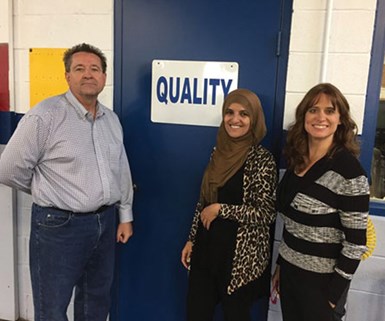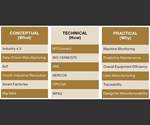Developing a Platform for Data-Driven Manufacturing
With the eventual goal of adding machine condition monitoring, this company began by installing an ERP system as a foundation to build upon, flattening the learning curve with each step toward achieving increased process oversight.
When you’re introducing a new system into your machining operations, it’s sometimes best to start with a clean slate. That’s especially true when you’re installing an enterprise resource planning (ERP) system as the basis for your entry into data-driven manufacturing. Legacy software doesn’t always merge well with newer technologies, or they might not connect seamlessly enough to allow both the existing and new programs to perform to their full capacity. Making a fresh start clears the way for creating a robust and streamlined system from the beginning.
That’s the approach management at Pioneer Service Inc. of Addison, Illinois, chose to take last year when it decided it was time to upgrade from an older ERP system it had been using to a new platform that would grow with the company and support its plans to eventually begin machine condition monitoring. The goal was to develop a system from the ground up that would provide granular information on each part, including exactly where it is in the machining process at any given point, as well as information on each individual machine and its cutting tools, and combine it all into a complete system overview that can be accessed from a single computer monitor or from tablets that can be carried throughout the facility.
The results so far, according to Aneesa Muthana, president, have been outstanding and have supported the company’s ambitions toward embracing data-driven manufacturing as a means of streamlining operations, avoiding equipment downtime and tooling failure and examining cost and/or delivery discrepancies.
A Pioneering Spirit
Established in 1990, Pioneer Service machines precision parts on its screw machines, CNC turning centers and Swiss lathes for the aerospace, automotive, construction equipment, medical, and petrochemical markets, among many others. The Swiss machine is for turning parts up to 1.25 inches on the OD, and the turning centers are for ODs as large as 8 inches. Working with materials such as stainless steel, aluminum, brass, titanium and plastics, the company also offers services including CNC milling and centerless grinding, delivering surface textures (RMS) to 0.15 micron and OD tolerances to within ± 0.0001 inch (2.5 microns).
About four years ago, the company’s revenues were primarily generated from machining motor shafts. Because of shifting market conditions, that work has largely dried up, leading the company to invest in new capabilities in order to pursue new markets. Initially a manual shop filled with Davenport and Brown and Sharpe screw machines, management decided to enter the world of CNC machining, eventually leading to a growing contingent of Swiss-type turning lathes. In order for these investments to reach their full potential, the company realized that upgrades were required in other areas as well.
Partially because of the age of its technology, the ERP system it had in place had an increasingly limited ability to provide data the company wanted to access, specifically having to do with tracking scheduling and production as well as traceability of its parts and materials. So with a list of search criteria—which included software with a good support staff and one that constantly improves its product—Ms. Muthana, along with colleague Rose of Sharon DeVos, business development manager, found the qualities they were seeking in an ERP system produced by Global Shop Solutions. Ms. DeVos says the Global Shop software package allows Pioneer to build from the ground up, choosing the exact data it wanted to gather in order to develop a shop management system tailored to the company’s specific needs.
Systems Oversight
After reviewing all of the options available in the Global Shop ERP package, the Pioneer team chose the following capabilities as most important for the company:
• Traceability provided by move tickets. Under the old system, shop managers used handwritten cards to check off processes as each part moved through the stages of the job. This led to human error in some instances, where certain machining steps were not completed and parts were therefore not in

Aneesa Muthana (middle) believes that work order comparisons provided by the Global Shop ERP package is one of the most important capabilities for Pioneer Service. Being able to access part status in real time has led the company staff to truly understand the quality embedded in each part it produces.
compliance with the customer’s requirements. Not only does this human error lead to excess scrap, but also wasted setup and machining time, and the relationship with the customer might also be compromised. Therefore, Global Shop worked with Pioneer to develop a “move ticket” process to provide tools for traceability and materials management. The process eliminates handwritten tickets and brings all information regarding parts—origin of materials and where each part is in the machining process, including multiple components of a single part, who worked on them, on what machine, and when—in real time. This is a huge advantage for Pioneer, enabling anyone in the front office or on the shop floor to answer a customer’s questions about the status of a particular order.
• Work order comparisons that improve costing accuracy. Although the ERP package came with a standard Work Order Comparison function, Pioneer modified its version to show estimated versus actual cost per piece rather than the total cost of the whole order. Ms. DeVos points out that the cost is adjusted as the part moves through the process, automatically adjusting the value as additional features are machined. Anything that doesn’t jibe between estimated and actual costs can be identified quickly and corrected accordingly. Saving both parts and the operator’s time is the primary benefit. Being able to access part status in real time has led the company staff to see machining and material costs from a new perspective: It allows Pioneer to truly understand the quality embedded in each part it produces.
• Reduction of staff overhead. Staff overhead was reduced thanks to the elimination of a significant amount of manual data entry. The company now spends approximately half the time it once did performing the process, with the oversight of a single employee rather than two. All process information is now available on a single computer monitor, eliminating the time it once took to search for paper documents in multiple locations. This “complete visibility in real time,” as Ms. Muthana calls it, also makes it easier to assign employees to operations and areas where they can be most effective, significantly improving on-time deliveries.
Never interested in merely maintaining the status quo, Ms. Muthana and her colleagues are harnessing the excitement derived by the success of the new ERP system to review other processes in search of achieving better efficiencies.
Asked to identify other areas of improvement made possible by the ERP system, Ms. Muthana says having the ability to scan, save and link documents (including quality certifications) into the system has dramatically reduced paperwork in all departments. Also, printing heat numbers on the move tickets and printing finished goods shipping tickets makes it easy to determine where a raw material came from, and from which supplier, she says. Performing daily balancing in the system improves accountability for all completed work while enabling more efficient payroll management for hourly employees. The ability to run sales reports by part, salesperson or customer allows for in-depth analysis of sales trends.
Monitoring the Future
As is often the case, the embrace of new technologies—and especially the daily proof of their efficacy—has led the company to see everything it does differently. Never interested in merely maintaining the status quo, Ms. Muthana and her colleagues are harnessing the excitement derived by the success of the new ERP system to review other processes in search of achieving better efficiencies.
For instance, in March 2013, Pioneer Service was awarded a Woman-Owned Small Business (WOSB) certification by the Women’s Business Enterprise National Council (WBENC). The certification not only helps the company’s existing customers meet their supplier diversity goals, it also opens doors to new opportunities via networking and provides a valuable competitive edge. (See Ms. Muthana’s column, titled “Benefits of Becoming a Certified Women-Owned Business.”)
From a philosophical standpoint, Ms. Muthana explains that Pioneer Service now embraces what she refers to as “science projects” or research and development, in other words. This approach involves seeing jobs requiring new machining skills not only as learning experiences, but investments in the company’s future, even if the first job landed doesn’t deliver profit margins that are especially high. Once the technique has been mastered, it becomes yet another machining capability for attracting new business. Not only that, but the company works with a consultant to identify and capitalize on tax cuts awarded to manufacturers that are involved in certain types of R&D. The company is also working with Global Shop to develop a means of determining exactly how much time and revenue is devoted to these projects.
The development of this tailored ERP system is an investment in the company’s financial bottom line, as it will lead to the addition of technologies. These technologies include condition monitoring, which will oversee all aspects of a machine’s operation such as heat parameters, process throughflow, tool wear and vibration. Such sensors can be set to respond to certain triggers by notifying equipment operators of any malfunctions and even alarming out and shutting down the machine, if necessary. The ERP system is “upwardly compatible,” meaning that it can be modified to incorporate new technologies as they are introduced.
Even beyond the many benefits related to process efficiency that the system has delivered, it has also provided the lesson that any machine shop owner—even one who has been involved in the business since she was 11 years old, handling everything from running machines to overseeing human relations and accounting—should keep in mind: if you’re not moving forward, you’re standing still and running the risk of being left behind by a company such as Pioneer Service Inc.
For more information from Global Shop Solutions, call 888-851-1248 or visit globalshopsolutions.com.
For more information from the Women’s Business Enterprise National Council, call 202-872-5515 or visit wbenc.org.
For more information about Pioneer Service (PMPA member since 2012) call 630-628-0249 or visit pioneerserviceinc.com.
Related Content
Automation Breakthroughs Revolutionize Precision Machining for Complex Parts
Marubeni Citizen-Cincom delivers custom solutions to address some of the biggest challenges in precision machining from handling small parts, to robot integration and unique tooling needs.
Read MorePiezoelectric Sensor Technology: Moving Toward more Efficient Machine Monitoring
A new system that uses simple and compact force or strain sensors, which can be integrated inside toolholders or mounted on surfaces such as spindle housings, can facilitate CNC machine monitoring.
Read MoreCNC Machine Shop Employment Positions to Consider Beyond Machine Operators
Many machine shops have open machine operator positions to fill. But does it make sense for shops to also seek automation engineers, IT managers and assembly personnel?
Read MoreVideo: Using AR for Remote Machine Tool Troubleshooting
Augmented reality can enable service engineers to help machine shops identify and possibly remedy issues with their machines remotely, perhaps eliminating the time and cost of an on-site diagnostic and maintenance visit.
Read MoreRead Next
Data-Driven Manufacturing Deconstructed
"Data-Driven Manufacturing" can be broken into three areas for better understanding: the conceptual, the technical and the practical.
Read MoreUsing ERP as a Foundation for Data-Driven Manufacturing
During a manual screw machine shop’s transition to CNC, it implemented an ERP system that will serve as the base for data-driven manufacturing.
Read More










.jpg;maxWidth=300;quality=90)









